When distinguishing between a wolf and a dog, we face the classic challenge of being able to sort out differences on a meaningful level.
Astronauts Could Rely on Algae as the Perfect Life Support Partner
Mankind is planning for long-duration crewed missions, one of the most important things is to make sure that the crews have enough of the bare essentials to last for a long time. This is no easy task, since a crewed spacecraft will be a crew’s entire world for months on end. That means that a sufficient amount of food, water and oxygen will need to be brought along.
What happens when a raindrop hits a puddle?
Why This Martian Full Moon Looks Like Candy
For the first time, NASA's Mars Odyssey orbiter has caught the Martian moon Phobos during a full moon phase. Each color in this new image represents a temperature range detected by Odyssey's infrared camera, which has been studying the Martian moon since September of 2017. Looking like a rainbow-colored jawbreaker, these latest observations could help scientists understand what materials make up Phobos, the larger of Mars' two moons.
Methane-consuming bacteria could be the future of fuel
New Clues About How Ancient Galaxies Lit up the Universe
NASA's Spitzer Space Telescope has revealed that some of the universe's earliest galaxies were brighter than expected. The excess light is a byproduct of the galaxies releasing incredibly high amounts of ionizing radiation. The finding offers clues to the cause of the Epoch of Reionization, a major cosmic event that transformed the universe from being mostly opaque to the brilliant starscape seen today.
The number of electric cars sold in Europe increased by almost 85%!
Forget the Anthropocene: we’ve entered the synthetic age
One fact about our time is becoming increasingly well-known. No matter how far you travel, no matter in which direction you point, there is nowhere on Earth that remains free from the traces of human activity. The chemical and biological signatures of our species are everywhere. Transported around the globe by fierce atmospheric winds, relentless ocean currents, and the capacious cargo-holds of millions of fossil-fuel-powered vehicles, nowhere on Earth is free from humanity’s imprint. Pristine nature has permanently blinked out of existence.
Health check: why do we get motion sickness and what’s the best way to treat it?
Beyond the Metal: Investigating Soft Robots at NASA Langley
NASA’s First Planetary Defense Technology Demonstration to Collide with Asteroid in 2022
The Double Asteroid Redirection Test (DART) – NASA’s first mission to demonstrate a planetary defense technique – will get one chance to hit its target, the small moonlet in the binary asteroid system Didymos. The asteroid poses no threat to Earth and is an ideal test target: measuring the change in how the smaller asteroid orbits about the larger asteroid in a binary system is much easier than observing the change in a single asteroid's orbit around the Sun. Work is ramping up at the Johns Hopkins Applied Physics Laboratory in Laurel, Maryland, and other locations across the country, as the mission heads toward its summer 2021 launch – and attempts to pull off a feat so far seen only in science fiction films.
Study: Nearest exoplanets to earth could host life
Ashes of a Dying Star Hold Clues about the Birth of our Solar System
Just 16 minutes of sleep loss can harm work concentration the next day
We’ve detected new gravitational waves, we just don’t know where they come from (yet)
Why some doctors are prescribing a day in the park or a walk on the beach for good health
Don’t write off abandoned buildings – they can be an important resource for the community
You need only look to the UK’s high streets to see myriad buildings in decline. Walk through any city or town and witness the empty shops, vacant office blocks and derelict housing. A recent report from the Royal Society for Public Health revealed that one in 10 high street shops in the UK is empty.
Starlink’s Satellites Will be Orbiting at a Much Lower Altitude, Reducing the Risks of Space Junk
Among Elon Musk’s many plans for the future, one of the more ambitious has been the creation of a constellation of satellites that will offer broadband internet access to the entire world. Known as “Starlink”, the company’s long-term plan is to deploy over 12,000 internet satellites to Low Earth Orbit (LEO) by the mid-2020s.
Dark Matter Detector Finds the Rarest Event Ever Seen in the Universe
Since the 1960s, scientists have theorized that the Universe is filled with a mysterious, invisible mass. Known as “dark matter“, this mass is estimated to make up roughly 85% of the matter in the Universe and a quarter of its energy density. While this mass has been indirectly observed and studied, all attempts at determining its true nature have so far failed.

















